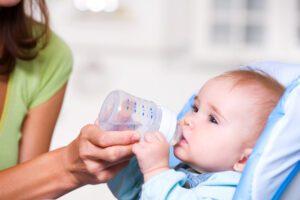Why is water important for infants?
As parents, we all know that water is important for our little ones, but do you know exactly why? In this blog, we’ll cover everything you need to know about water for infants, from when they can start drinking water to how much they need and how to introduce it to them.
Water is essential for infants because it helps regulate their body temperature, aids digestion, and supports brain development. In this blog, we’ll go over some important guidelines to help ensure your infant gets the right amount of water they need to thrive.
When Can Infants Drink Water?
When it comes to introducing water to infants, it’s important to follow some guidelines to keep them safe and healthy. Generally, it’s safe to give water to infants when they are around 6 months old and have started eating solid foods.
However, giving water to infants too early can be dangerous. Infants’ kidneys are not fully developed, and too much water can disrupt the balance of electrolytes in their bodies, which can lead to serious health issues like hyponatremia.
To introduce water to your infant, it’s best to start with small amounts and gradually increase as they get older. Aim to give them no more than 2-4 ounces of water per day until they are 6 months old, and then you can increase the amount gradually as they start eating more solid foods. As always, be sure to talk to your pediatrician for personalized advice on when to introduce water to your little one.
How Much Water Should Infants Drink?
Just like adults, infants need water to stay hydrated and healthy. But how much water do they really need? Generally, infants need around 2-4 ounces of water per day, depending on their age and weight.
There are several factors that can affect how much water an infant needs, including the temperature and humidity of their environment, how much they are sweating or urinating, and whether they are sick. It’s important to monitor your infant’s water intake and adjust accordingly to make sure they are staying hydrated.
One easy way to monitor your infant’s water intake is to keep track of their wet diapers. A well-hydrated infant should have at least 6-8 wet diapers per day. If you notice your infant is not having enough wet diapers or seems to be lethargic or unwell, be sure to talk to your pediatrician for advice on how to increase their water intake.
Is Tap Water Safe for Infants?
We want to make sure that the water we give our infants is safe and free of contaminants. While tap water is generally safe to drink, there are some potential risks that can be harmful to infants.
Tap water may contain contaminants like lead, bacteria, or chemicals that can be harmful to an infant’s health. To ensure that your tap water is safe for your little one, it’s important to follow some guidelines. First, make sure to test your tap water regularly for any potential contaminants. You can contact your local water provider or purchase a home testing kit to check the water quality.
In addition, be sure to use cold tap water when preparing formula or food for your infant. Hot water can dissolve lead or other contaminants more easily than cold water. Also, be sure to use a certified water filter or bottled water if you have any concerns about your tap water quality.
If you prefer an alternative to tap water, you can consider using distilled water or purified water specifically labeled for infant consumption. However, it’s important to note that these alternatives may not contain the necessary minerals and fluoride that tap water provides for your infant’s growth and development. As always, be sure to talk to your pediatrician for personalized advice on which water source is best for your infant.
How to Introduce Water to Infants
Introducing water to infants can be an important step in their development, but it’s important to do so safely and gradually. Here’s how to introduce water to your little one:
Start by offering small amounts of water, around 1-2 ounces at a time, after a feeding. You can use a bottle or a sippy cup with handles to make it easier for your little one to hold. Some infants may prefer warm water, so you can warm it up slightly if needed.
To make water more appealing to your infant, you can try adding a small amount of fruit juice to the water or offering it during playtime as a fun activity. It’s important to note, however, that fruit juice should only be given sparingly and should be diluted with water.
When introducing water to your infant, it’s important to avoid some common mistakes. For example, don’t give your infant water instead of formula or breastmilk, as this can lead to dehydration and malnutrition. Also, don’t force your infant to drink water if they are not interested, as this can create negative associations with drinking water.
Remember, introducing water to your infant should be done gradually and with care. If you have any concerns or questions about how to introduce water to your little one, be sure to talk to your pediatrician for personalized advice.
Signs of Dehydration in Infants
Dehydration can be a serious condition for infants, so it’s important to know the signs and take action quickly if you suspect your little one is dehydrated. Here are some common signs of dehydration in infants:
Dry mouth and tongue
Fewer wet diapers than usual
Sunken soft spot on the head
Irritability or lethargy
No tears when crying
If you notice any of these signs, it’s important to act quickly to prevent further dehydration. Offer your infant small amounts of water or breastmilk/formula more frequently, and consider consulting with your pediatrician for further advice. Severe dehydration can be life-threatening, so it’s important to seek medical attention if you suspect your infant is severely dehydrated.
Preventing dehydration in infants is key to their overall health and well-being. Here are some tips for preventing dehydration:
Offer breastmilk or formula frequently, especially during hot weather or if your infant is sick
Monitor your infant’s wet diapers to ensure they are staying hydrated
Offer small amounts of water after feedings as your infant gets older and is ready to drink water
Avoid exposing your infant to extreme heat or direct sunlight
Remember, as a parent, it’s important to stay aware of your infant’s hydration levels and take action quickly if you suspect they are dehydrated. With these tips, you can help ensure your little one stays healthy and hydrated.
Conclusion
In summary, water is an important part of a healthy diet for infants, but it’s important to introduce it safely and monitor their intake to ensure they stay hydrated. Here are some key takeaways to remember:
Wait until your infant is around 6 months old to introduce water
Offer small amounts of water, around 1-2 ounces, after feedings as your infant gets older and is ready to drink water
Tap water can be safe for infants if it’s properly filtered or boiled
Watch for signs of dehydration and take action quickly if you suspect your infant is dehydrated
Overall, ensuring your infant gets enough water is key to their overall health and well-being. By following the guidelines for introducing water safely and monitoring their intake, you can help ensure your little one stays healthy and hydrated. If you have any concerns or questions about your infant’s water intake or hydration levels, be sure to talk to your pediatrician for personalized advice.








